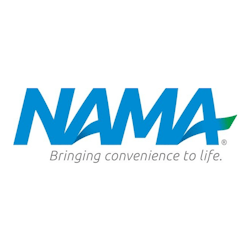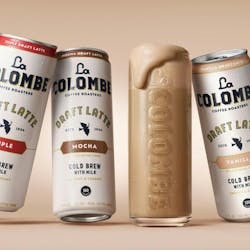The opening seminar at the National Automatic Merchandising Association CoffeeTea&Water Show provided an in-depth presentation on trends in the coffee service channel and suggestions on how to respond to them. Ross Colbert, global beverage strategist for Rabobank, an international bank, presented a detailed assessment of the coffee market that included suggestions for coffee service operators whose livelihoods depend on understanding the fast changing market.
Colbert was a featured keynote speaker for the event held at Bally’s resort in Las Vegas from Oct. 18 to 20, 2011. About 350 attended the opening seminar.
Colbert began by noting his company, Rabobank, is the largest bank covering the agribusiness industry. Rabobank follows brands, roasters and growers in many food and beverage categories.
Before going in-depth in the office coffee service (OCS) market, Colbert presented trends affecting the coffee industry as a whole.
He noted that coffee consumption is increasing globally. Hence, it stands out among other beverages that have been more adversely affected by the global recession.
He noted there are two divergent consumer trends caused by the recession; affluent consumers choosing to spend less frequently but spending more when they do spend, and less affluent consumers trending down to reduce expenditures. These divergent trends favor the higher and lower ends of the beverage market.
“We see this polarization across all beverage segments,” Colbert said.
One impact has been a growth in soluble coffee since it is less expensive. Another factor driving soluble coffee is that the technology used to produce it has improved. “The technology is catching up with the demand,” he said. “We’re bullish on instant coffee.”
Colbert offered one of the more optimistic recent assessments about coffee prices. He thinks the upward trend will level off in 2012. “The good news is coffee pricing is easing up,” he said.
Colbert then focused his comments on OCS, which he noted posted a slight recovery in retail sales in 2010 and 2011. He said the improvement has been largely driven by higher prices passed on to OCS customers.
The OCS customer base is contracting due to economic conditions, he noted. He cited this as a long-term challenge for the OCS industry.
Other challenges for OCS include: margin pressure, competition from other channels, the emergence of consumer brands in OCS, and challenges posed by single-serve technology.
“There are still some significant issues at hand,” he said.
He said OCS operators must think more strategically than they have traditionally.
The influx of single serve systems has been and will likely continue to be the biggest change in the industry, he said. He then showed market share figures from Automatic Merchandiser’s State of the Coffee Service Industry Report and figures from Rabobank.
Automatic Merchandiser reported that single-cup systems represent 20 percent of OCS machines while Rabobank estimates it at 30 percent.
While single-serve has many benefits to customers and operators, it has certain challenges, Colbert said.
On the plus side, single-serve has higher selling prices, ease of use, less mess, higher quality, and a customized solution. On the negative side, it has lower margins, increased inventorying costs, increased competition from other channels, delayed entrance and exist of customers from the OCS market, and an inability to provide private label options.
“The influx of single-serve has been very disruptive,” he said. In markets such as New York City where single cup commands as much as 60 percent of all OCS machines, he said the dominance has favored the larger OCS operators at the expense of the smaller operators.
In addition, he said the popularity of single-cup invites competition from other channels.
“It opens the door for the do-it-yourselfer,” Colbert said.
Colbert then noted that the leading single-cup system manufacturers have different marketing strategies.
The manufacturers using what he called the “push” strategy are helping operator customers market to customers. Those using what he called the “pull” strategy are focusing on building a brand and creating customer demand to drive market penetration.
He said market uncertainty exists due to the expiration of K-Cup patents in 2012.
Colbert said OCS operators need to understand manufacturer marketing strategies.
OCS operators in markets with low single-cup penetration have time to learn manufacturer strategies and determine how they as operators can best take advantage of these strategies.
Operators in markets with high single-cup penetration need to know what their existing contracts indicate for future business relationships.
Manufacturers can change their prices which impact operator costs.
“In this environment, that’s the one thing that will eat you alive if you’re not paying attention to it,” Colbert said.
The introduction of strong consumer coffee brands in OCS has also presented a new set of challenges, he noted. He said these brands cause consumers to compare offerings from OCS with other channels.
Colbert then presented some operator market information based on his own company’s research. He said national operators have 50 percent of the market, independents 15 percent, retailers 25 percent, and online merchants 10 percent.
He said OCS operators can differentiate themselves from other channels with service, along with product freshness, variety and quality.
He said operators should understand the positioning of competitors and identify key selling points against these competitors.
Online merchants, for instance, offer low price and ease of ordering.
Home and office retailers offer bundling of different products and ease of buying.
Club stores offer low price.
Full service product suppliers offer convenient one-stop shopping.
In each case, the OCS operator can offer superior service.
Colbert said OCS operators need to base their strategy on service, diversification, and what he termed “right size and shape of business,” meaning an efficient operating structure.
He then listed six beverage trends OCS operators can take advantage of: Gatorade, coconut water, energy drinks, ready-to-drink cold coffee, stevia-based beverages such as vitaminwater Zero, and green tea. He said these are low volume products compared to coffee, but high margin.
Two other markets he encouraged operators to expand into are office snacks and pout of use water systems.






